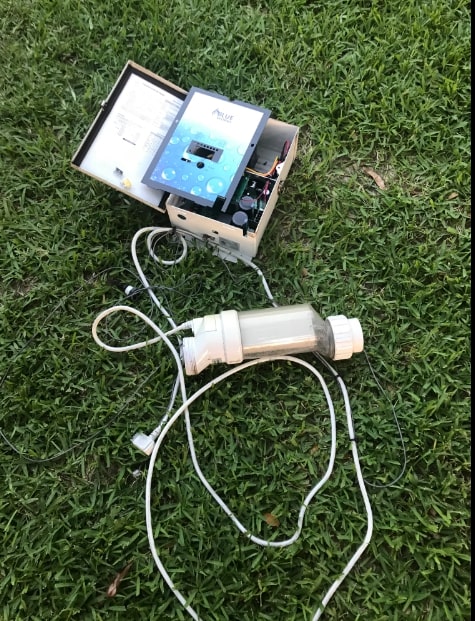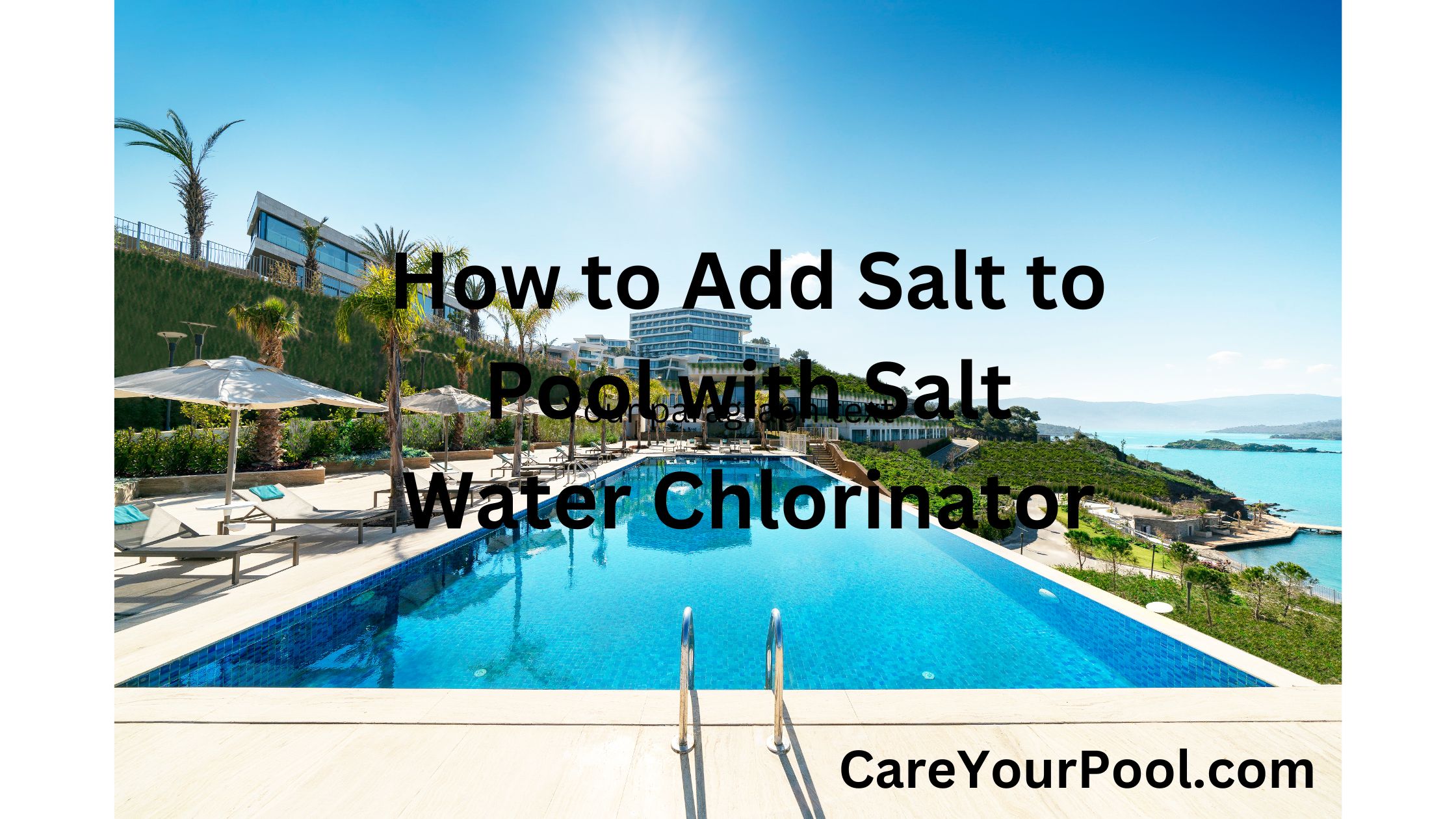If you own a pool, you are aware of how crucial it is to keep the chemical balance in your pool in good order. Using a saltwater chlorinator to add salt to your pool is a crucial step in this procedure.
A saltwater pool system is a popular and efficient way to maintain your pool fresh and sparkly, but for the system to function correctly, your pool must have the right quantity of salt added. We’ll walk you through the process of how to add salt to pool with Salt Water Chlorinator in this blog article.
Firstly, you have to determine how much salt is required according to your pool’s water level. Then, you need to prepare the pool with some necessary materials.
After that, you have to add the salt to the Salt Water Chlorinator and then test it. Remember, you need to add that salt to the pool’s water system.
Learn the Basics: What is a Salt Water Chlorinator?
Salt water chlorinators are devices that assist you in maintaining a clean, safe, and healthy swimming pool. They help filter out the chlorine so you may use less of it and are used in pools that are not linked to the municipal water supply.
Natural sea salt is used by Salt Water Chlorinators as a supply of electrolytes. The salt in the machine becomes electrically charged when it is turned on by the machine’s electric current, which enables it to draw additional particles into its interior chamber. The particles are then removed from your swimming pool by being captured in a filter.
A Step-By-Step Guide on How to Add Salt to Pool with Salt Water Chlorinator

One of the quickest and simplest methods to enhance the water quality of your swimming pool is to add salt to it. Using salt water chlorinators, it may be finished in as little as 15 to 20 minutes. This is a step-by-step tutorial on utilizing a Salt Water Chlorinator to add salt to a pool.
Determining the Required Amount of Salt
Determine the necessary amount of salt before using a saltwater chlorinator to add it to your pool. Your pool’s size and the manufacturer’s recommendations for your saltwater chlorinator will determine how much salt you need to apply.
The manufacturer should be contacted or your chlorinator’s handbook should be checked to discover how much salt is needed. To figure out how much salt your pool needs, you may utilize an online pool calculator.
Here is a table chart that would be a great help to you while adding salt to your Salt Water Chlorinator.
| Water Volume (Gallons) | Salt Required (lbs) |
| 5,000 | 30 |
| 10,000 | 40 |
| 15,000 | 65 |
| 20,000 | 80 |
| 25,000 | 100 |
| 30,000 | 125 |
| 35,000 | 150 |
| 40,000 | 160 |
This table chart illustrates how much salt is needed to fill various water volumes in a saltwater pool to reach the acceptable salt level of 2,500 to 3,500 parts per million (ppm). The amount of salt needed may differ based on the specific saltwater chlorinator being used and the manufacturer’s instructions, so be sure to refer to your chlorinator’s handbook or contact the manufacturer for advice.
Prepare the Pool for Adding Salt
There is a list of materials you will be needing while preparing the pool before adding salt with the help of Salt Water Chlorinator.
- Pool Brush
- Pool Vacuum
- Pool Skimmer
- Water Testing Kit
- Salt
- Bucket
- Chemical Dispenser
- Chlorine Stabilizer (optional)
- Calcium Reducer (optional)
- pH increaser and decreaser (optional)
- Alkalinity increaser and decreaser (optional)
It’s crucial to remember that the particular supplies you require may change based on your pool’s size, shape, kind, saltwater chlorinator you’re using, and the chemical balance of your pool at the time.
For further instructions on preparing your pool for salt, be sure to refer to the user guide for your chlorinator or get in touch with the manufacturer. You could adjust the alkalinity and pH level of your pool with the necessary increasers and decreasers.
Adding Salt to Pool with Salt Water Chlorinator
If you’re wondering how to use a saltwater chlorinator to add salt to a pool, it’s simple. Simply add the necessary amount of salt to the pool, and the salt chlorinator will take care of the rest.
Using a salt water chlorinator to add salt to a pool is a straightforward technique that helps maintain the proper salt level for a clean and comfortable swimming experience. Before adding salt, check the current salt level in your pool using a salt test kit or a salt meter. This will give you an estimate of how much salt you’ll need to reach the required level.
After determining the amount of salt needed, select pool-grade salt formulated exclusively for saltwater pools. Use of table salt or salt with additives should be avoided as they may impair the efficiency of your salt chlorinator. To achieve the best outcomes, high-quality salt should be used.
Make sure the pool’s circulation system is turned on before adding salt. This aids in the uniform distribution of salt throughout the pool. Slowly pour the needed amount of salt into the pool, making sure to distribute it evenly. This aids in appropriate dispersion and prevents salt concentrations.
Allow the pool’s circulation system to run for several hours after adding the salt. This allows the salt to dissolve and completely dissolve in the pool water. It’s crucial to note that the salt may take some time to dissolve completely, so be patient.
The chlorine from the saltwater chlorinator and the salt will dissolve in the water to create sodium hypochlorite, a chemical that kills bacteria and algae. and water is combined.
You only need to add 40 pounds (or 20 buckets) of salt to your pool if, for instance, the salt concentration is 1,000 ppm and you need to add 4 pounds of salt per 10,000 gallons of water. The rest is handled by the chlorinator.
You can use regular table salt, but if you can get it, it’s preferable to use solar or pool salt. Your owner’s handbook will provide a chart that will show you how much salt to put based on the size of your pool.
Chlorinator working its magic. The appropriate amount of salt will be automatically added to your pool water if you are utilizing a chlorine dispenser or floater.
And if you are constantly running into problems, go seek help from a pool professional. Here you can find pool experts near you in New Jersey.
Keeping your pool correctly balanced is the greatest method to prevent salt damage. Contact a reputable pool care company like The Pool Doctor of West Michigan if you’re unsure how much salt to add.
Use a chlorine test kit if you have a saltwater pool and are adding salt to make sure the water is within the right range. Add additional salt until the chlorine concentration reaches 1 ppm, if necessary.
Testing the Salt Levels
You must test the salt levels in your pool after adding salt to make sure they are at the right level. To determine the salt content of your pool, utilize a saltwater test kit. Aim for a salt concentration of between 2,500 and 3,500 ppm (parts per million).
You must add extra salt to the pool if the salt levels are too low. On the other side, you’ll need to dilute the water to lower the salt levels if they’re too high.
You must test the salt levels in your pool after adding salt to make sure they are at the right level. To determine the salt content of your pool, utilize a saltwater test kit. You can learn how to test a Salt Chlorinator cell. It will help you with completing the tests by yourself.
How to Add Salt to Salt Water Pool System
Using a salt chlorinator to add salt to a salt water pool system is a simple process. First, use a test kit or a meter to determine the current salt level in your pool.
Calculate the amount of salt required based on the volume of water in your pool. Select pool-grade salt that has been specially prepared for salt water pools.
Slowly pour the salt into the pool while the circulation system is working, dispersing it evenly throughout the water surface.
Allow the salt to dissolve for several hours before retesting the salt level and making any required adjustments. Monitor and maintain the salt level on a regular basis to guarantee that your salt chlorinator runs well.
Always adhere to the manufacturer’s recommendations for your unique salt chlorinator system.
Consult your pool technician or the manufacturer if you’re unsure how much salt to add. Online or on the product box, instructions are also available. You should also learn more about Salt Water Chlorination for your own benefit. Like, you should know how long does a Salt Generator Take to make chlorine.
When and how much salt to use will be specified by the manufacturer. This is crucial since adding too much salt to the pool water might damage your equipment or result in an excessive chemical balance. That’s why you need to learn how often to run Salt Chlorinator.
Where to Add Salt to a Saltwater Pool
When adding salt to a saltwater pool, it is critical to understand where and how to distribute the salt appropriately. To ensure even dispersion, the salt should be applied directly to the pool water, ideally in areas with good circulation. Here are the actions to take:
- Begin by measuring the recommended amount of salt based on the size of your pool and the existing salt level. For particular salt dosage, consult the manufacturer’s instructions or a pool professional.
- Turn on the pool pump to ensure proper circulation of the water.
- Pour the salt slowly into the pool, spreading it out as evenly as possible. Pour the salt into different places in the pool to help with dispersion.
- Avoid putting salt directly into the skimmer or pool filter since it can damage the equipment.
- Allow the pool pump to run for several hours or overnight to help dissolve and spread the salt.
- After some time, use a salt test kit to check the salt level in the water. Adjustments can be made by adding more salt if the level is too low or diluting the water if it is too high.
Final Words
It’s vital to remember that even though using a salt water chlorinator to add salt to a pool is rather simple, but it’s still necessary to have the right chemical balance in the pool and clean it frequently to avoid problems like algae development, pH imbalances, and hazy water.
Also, it’s crucial to refer to your saltwater chlorinator’s handbook or get in touch with the maker for detailed instructions and suggestions because the amount of salt needed and the method for adding it depends on the particular chlorinator being used.
You may take advantage of crystal-clear water and a cooling swimming experience all season long by properly preparing your pool for salt and maintaining it on a regular basis.
If you have any other queries like, How do pool lights work? You can rely on us and search for it on our website.
Meta Description: Learn how to add salt to your pool with Salt Water Chlorinator here. Discover how to find the right amount of salt, prepare the pool for salt and many more
Read more, Learn more:
How many 1-inch chlorine tablets for 1000 gallon pool
How to change a pool light without draining the water
How often to run robotic pool cleaner
